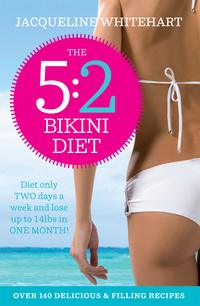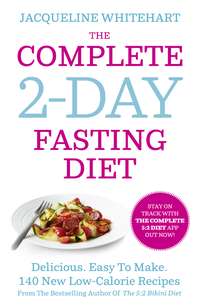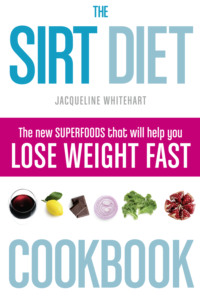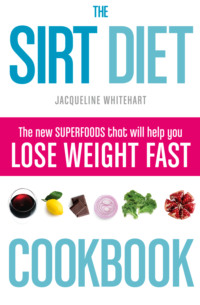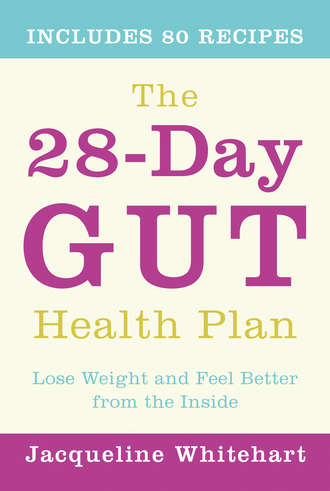
Полная версия
The 28-Day Gut Health Plan: Lose weight and feel better from the inside
Garlic
Garlic paste
Garlic flavouring
Garlic salt
Leeks
Note that the green part of a spring onion is allowed, as are chives and celery. Garlic oil is also allowed (and makes a fantastic substitute). The damaging part of the garlic is not soluble in oil, so a garlic-infused oil contains lots of garlic flavour without any of the risks.
Other vegetables
Broccoli
Cauliflower
Kale
Cabbage
Beans and lentils
All kinds of beans including:
Kidney beans
Baked beans
Haricot (navy) beans
Butter beans (lima beans)
Borlotti beans
Black-eyed beans
Soy beans
All kinds of lentils including:
Red lentils
Brown lentils
Puy lentils
Chickpeas should also be avoided.
WHEAT
If you have a fat tummy, love handles or ‘man boobs’, you are not alone. Look around you. The characteristic paunch is extremely common. It gets worse as you get older, and is virtually impossible to shift through diet and exercise. What if this unshiftable belly is caused by twenty years of wheat overload? There’s new thinking that suggests that wheat could be the primary cause of your inflated belly and bloating.
Why avoid wheat?
Not all carbs are the same. Starchy or complex carbs such as rice, oats and potatoes release their energy more slowly than sugar, which is a simple carbohydrate. But isn’t wheat a complex carbohydrate? Yes. But it has unique properties that actually make it release its energy at the same rate as sugar.
Think about how much wheat you eat daily. It’s probably part of every meal. And if you have a snack it’s likely to be present there too. Could the problem be wheat overload? We know that wheat cannot be fully digested and may cause small tears to appear in the intestines.
Cut out wheat entirely
As wheat is in so much of the food you eat you’ll need to start looking at the packaging of every food you buy. Even better, stick to whole, natural foods which don’t come in a packet, and get back to basics with your cooking.
Foods to avoid
Bread
Cake
Biscuits
Pastries
Pies
Crackers
Pitta or wraps
Beer
Malt or malt extract
Pasta
Noodles
Pancakes
Breakfast cereals
Barley
Rye
Bulgur wheat
Gluten-free products – good or bad?
You need to approach gluten-free food products with caution. These processed foods are often full of very quick-release carbohydrates such as rice flour and sugar. Your best bet is to prepare your own food, which you can guarantee as gluten-free naturally.
However, I have found that it helps to feel less restricted if you can have access to a gluten-free bread now and again. We are lucky that there are now hundreds of gluten-free products available. If you find a gluten-free bread that you like, then you should treat yourself occasionally. Even better, buy a gluten-free bread flour and make your own gluten-free bread. I have perfected my own recipe for this and you’ll find it in the Step Up Recipes section.
EVERYBODY IS DIFFERENT
MY OWN JOURNEY


I used to feel bloated even after eating a small meal. Bloating is so subjective, it’s hard to know the exact cause and solution. I didn’t tend to feel poorly, so it was hard to pin it down to any one cause. I also got eczema on my face and had a tendency to migraines.
After much experimentation last year (this programme is intended to cut out the grey areas allowing you to reach your own conclusions much quicker), I discovered that wheat was the problem. The difficulty is that with bloating caused by wheat intolerance (which is so common), it doesn’t come straight after eating wheat; it comes maybe a day later and lasts about forty-eight hours. So if I eat wheat on the Monday, I might not get symptoms until Tuesday and they won’t completely disappear until Thursday. It’s so easy to eat a little bit of wheat every day and then the bloating never really goes away.
I cut out wheat completely for a few months and felt a lot better for it. My eczema cleared up nicely and the frequency of my migraines decreased. All due to cutting out wheat.
That’s not quite the end of the story. And this may be familiar to some of you. I was feeling better and I knew this was due to cutting out wheat. I wanted to try and reintroduce it slowly. I missed bread. And the first few times I experimented with bread it seemed fine. A bit of bloating the day after eating wheat is easy to overlook. Unfortunately, this led to me, almost imperceptibly, going back to eating wheat every day. And slowly but surely my symptoms returned. It took seeing my stomach in the mirror to acknowledge it. My tummy was not fatty or flabby … just bloated.
My new plan, which I have been following successfully for the past few months, is to cut out wheat entirely once again. But I make a wheat-free loaf of bread and eat gluten-free bread most days (see here). I have to use a rice flour to make the bread, which isn’t ideal. But I have realized that total wheat restriction is no fun in the long run. So my long-term rules for me are: no wheat and no processed foods. But if I want to eat chocolate, gluten-free bread or make some cookies containing real sugar, I do.
Let’s hear from some other people I have helped find their own trigger foods, and who enjoy their life more due to a greater understanding of their gut health.
ANGELA


Angela has been getting stomach cramps at night for thirty years. Not every night, but sometimes they are so bad that she barely sleeps at all. She noticed a correlation with nightshade, so for a long time she has avoided tomatoes in all their forms. Her symptoms became progressively worse over the years. She then tried removing wheat and dairy from her diet with little success.
It was only on total removal of all gas-producing foods that her symptoms improved.
Angela’s triggers are nightshade and gas-producing vegetables. In particular, she knows that even a tiny bit of onion or garlic will trigger her symptoms. Tomatoes in small doses and cooked tinned tomatoes are less of a problem.
Her solution is to avoid onions, garlic, leeks, beans and lentils totally. She also takes probiotics when her stomach is weak or when she needs antibiotics. She takes a fibre supplement (a teaspoon of ground psyllium) daily.
Angela allows herself to consume tomatoes and peppers in small amounts up to three times a week. She also eats wheat and dairy freely.
STEPHEN


Stephen is a busy executive who has a stressful job. In a particularly difficult period at work, his symptoms became unbearable and made it difficult for him to do his job properly.
On the advice of the doctor, he cut out all five triggers until his symptoms abated. Then, after a long period of trial and error, it became clear that it was the milk in his many cups of tea that was the problem. Stress also exacerbated the symptoms. His treatment involved probiotics for three weeks to rebuild the gut.
He now does not have milk or yogurt, although cheese is fine. He also is careful about how much red meat he eats. Meat in moderation is fine, but overindulgence can cause his symptoms to reappear.
ANTONIA


Antonia found her symptoms were making her miserable and interfering with her life. She chose to take a food-intolerance test, which highlighted red meat, milk and wheat.
Antonia avoids these three triggers entirely and she is now symptom-free.
JOHN


John didn’t feel he had any intolerances or symptoms. However, he did notice that he was bloated after meals and struggled to lose weight despite eating more healthily. John consumed a lot of wheat (as many of us do), so he decided to cut it out for one month to see if he noticed the difference. After a month wheat-free he felt so much better – more energy, no bloating and yes … he’d lost half a stone.
John now eats wheat only on special occasions – a rustic roll in a restaurant or a piece of homemade birthday cake – with no symptoms, but he knows that if he eats wheat more regularly his symptoms will return.
FOOD AND DRINK
You may be wondering what on earth you can safely eat on the programme. There’s plenty of truly nutritious and safe food that’s available and not too complicated to make. I’ll also introduce you to some great Healing Foods (that can help your gut recover faster) and some Hero Foods that add lots of flavour without risking your gut.
SAFE FOODS
These are the foods that you know are 100 per cent safe to eat at any stage of the plan.
Meat, fish and eggs
Chicken
Turkey
Eggs
Fish
Prawns
Salmon
Tuna
Tofu
Dairy and alternatives
Lactose-free milk
Almond milk
Soya milk
Coconut milk
Butter
Cheddar
Feta
Brie
Goat’s cheese
Mozzarella
Swiss cheese
Parmesan
Vegetables
Carrot
Bean sprouts
Green beans
Beetroot
Pak choi
Celery
Celeriac
Chives
Spring onion (green part only)
Sweetcorn
Courgette
Cucumber
Fennel
Ginger
Lettuce
Rocket (arugula)
Peas
Potatoes (without skin)
Spinach
Sweet potato
Butternut squash
Swiss chard
Water chestnuts
Fruit
Avocado
Banana
Blueberries
Orange
Satsuma/clementine
Lemon
Lime
Grapes
Kiwi
Melon
Pineapple
Pomegranate seeds
Raspberries
Strawberries
Rhubarb
Nuts and seeds
Almonds (ground almonds)
Walnuts
Hazelnuts
Macadamia nuts
Peanuts
Pecans
Pine nuts
Chia seeds
Pumpkin seeds
Sesame seeds
Sunflower seeds
Grains and cereals
Oats
Rice
Buckwheat
Cornflour (cornstarch)
Oatbran
Polenta
Quinoa
Fats and Oils
Mild olive oil
Olive oil
Extra-virgin olive oil
Confectionery and sugar
Dark chocolate
Honey
White sugar
Brown sugar
Maple syrup
Herbs and spices
Basil
Chives
Coriander (cilantro)
Ginger
Parsley
Rosemary
Tarragon
Thyme
Cinnamon
Cumin
Five spice
Star anise
Turmeric
Asafoetida
Sauces
Mustard
Tamari (wheat-free) soy sauce
Maple syrup
Balsamic vinegar
Apple cider vinegar
Peanut butter
Mirin
Worcestershire sauce
Fish sauce
HEALING FOODS
If you want foods that not only are ‘safe’ but also help heal the gut from the inside then these are my absolute top foods. Some, like kombucha, help reduce inflammation of the gut, some improve the bacterial balance and others help the digestive tract run more smoothly.
Apple cider vinegar and balsamic vinegar
Both these vinegars taste amazing and are so versatile. I make a simple salad dressing with both and it is absolutely delicious. Apple cider vinegar and authentic balsamic are fermented foods. Fermented foods are natural sources of really good gut bacteria. These bacteria complement those found in probiotics and help you gain the best balance. Both vinegars also contain acetic acid (it’s what makes them sharp) which helps lower the sugar that we absorb from our food. Here is my perfect go-to salad dressing …
Everyday Healing Vinaigrette
Simply mix together 1 tbsp extra-virgin olive oil, 2 tsp apple cider vinegar, ½ tsp balsamic vinegar, ½ tsp English mustard and a generous seasoning of salt and black pepper.
Kombucha
Kombucha is a fermented tea drink. It naturally inhibits the growth of harmful bacteria and has a soothing and anti-inflammatory effect on the gut lining. If you think you have a leaky gut and it is making inflammatory conditions such as arthritis and acne worse, then kombucha may be beneficial for you. There are some amazing online shops selling kombucha drinks that are worth hunting down. And if you find the drink helpful, you can then go on to make your own easily and relatively inexpensively.
Tamari wheat-free soy sauce
Instead of standard soy sauce, you can now buy tamari soy sauce from most supermarkets. It’s a fraction more expensive but not disastrously so. Naturally fermented and wheat-free, it adds different bacterial strains to the probiotic mix.
Psyllium husks
Psyllium is a prebiotic powder that you can buy from health-food shops. I recommend it as it’s the purest and simplest way of adding prebiotics to your diet. Prebiotics are a special type of fibre that complement probiotics as they encourage the growth of good bacteria in your gut. Think of prebiotics as food for the good bacteria. Once you have ‘sown the seed’ of probiotics, prebiotics will encourage the good bacteria to grow and flourish. Additionally, the fibre element helps keep your digestive system running smoothly and relieves both diarrhoea and constipation symptoms.
I use psyllium in gluten-free bread recipes, but you can also dissolve a teaspoon in water or juice. It is a very concentrated fibre source, so it is important to drink at least two glasses of water or juice with every teaspoon.
Olive oil
The more natural the oil or fat the better. For this reason the ONLY fats I use in cooking are olive oil and butter. Olive oil is by far the least processed of the oils we use and has a very high percentage of heart-healthy monounsaturated fat. You can get olive oil in three varieties (and I use them all): ‘normal’ olive oil is my go-to oil for frying and general cooking, extra-virgin olive oil is fabulous in salad dressings and mild (or light) olive oil is great for baking or anywhere you just need an oil without the olive oil flavour.
HERO FOODS
When you’re avoiding whole food groups, it’s easy to feel that you’re cutting out all the flavour and excitement from your food. After all, if you cut out meat, tomatoes, onion and wheat, what is left?
Actually, there is plenty, but to avoid bland food you have to be a little bit clever with your food swaps. You’ll find that I use all of the swaps listed here in the Gut-Health Plan Recipes and they are key to moving forward and living with food intolerances, whether just for the short term or if you find you need to avoid these foods for the foreseeable future.
Lactose-free milk
Lactose-free milk can now be found in any supermarket; it’s only a little bit more expensive than your standard semi-skimmed. What’s more, you can’t taste the difference, so it’s one of the easiest swaps ever. There are also lactose-free yogurts and ice cream but they are a little bit harder to find.
Onions and garlic
Onions and garlic are perhaps the hardest foods to avoid. If you think about it, the vast majority of our meals contain them in some form or another. If you’re buying pre-prepared food, it’s practically guaranteed. The problem is exacerbated by the fact that only a small quantity can set off an intolerance, so we need to be very careful indeed.
Garlic oil
Garlic oil is extra-virgin olive oil infused with garlic. Unlike garlic powder or pastes, the oil picks up the flavour of the garlic but without the troublesome ‘gassy’ molecules. This is because the garlic is not soluble in the oil, but it is in water. Garlic oil is brilliant because it can be used in practically any dish that requires garlic. Simply substitute 1 teaspoon of garlic oil for 1 clove of crushed garlic. Garlic oil is completely safe for sensitive tummies. You could also try chilli oil as a great way to add heat to a dish without the chilli.
Celery
Celery should be your go-to onion substitute in many dishes. It has a slightly milder flavour than onion. But if you add one or two chopped celery sticks in the place of an onion in a dish, particularly a traditional British dish like Cottage Pie (see here), then you won’t notice the difference.
Asafoetida
If you’ve not heard of asafoetida before, you are not alone. It’s not a commonly used spice outside of the Indian sub-continent. A yellow spice, also called ‘hing’, it can be purchased cheaply and easily from the supermarket. In cooking it adds a mild onion or leek flavour to any dish. You need about a teaspoon as a substitute for an onion and it does add a yellow colour. It really is fantastic for adding warmth and depth of flavour to a dish. I’m a total convert and use it in many dishes.
THE PROBLEM WITH PROCESSED FOODS
Here’s the thing: processed foods are bad for you. We all know it. But they are immensely hard to avoid. They are the primary cause of the modern obesity epidemic and the root cause of so many food allergies and intolerances. Honestly, I would prefer it if you ate a huge slice of homemade chocolate cake, rather than one ‘healthy’ shop-bought granola bar.
Processing brings preservatives, colourants and flavourings. But it also has no regard for the delicate balance of our gut. The refining and sanitizing of the product, together with hidden sugars and unnatural chemicals, means that any processed or pre-prepared meal is an alien invader on the sensitive gut.
How do we define a processed food?
As a simple rule of thumb:
‘If it has an ingredients list and that list contains more than three ingredients, then that is a processed food.’
This isn’t as bad as it sounds! Obviously meat, cheese, milk and vegetables are all fine as they don’t have an ingredients list at all. And we are not ruling out food that has been tinned or processed for longer life, either. Tinned tomatoes, for example, are fine. As is smoked salmon. You’ve also got all those blessed timesavers like pre-cooked rice, ready-to-eat lentils or beans, or pasta. You can even have bread – as long as you make it yourself …
But we are getting ahead of ourselves. A lot of these foods need to be banished temporarily while we get on top of the current condition.
TIME FOR A REBOOT?
Think of the 28-Day Gut-Health Plan as a month of bed rest and recuperation for your gut. At the end of the programme, not only will your gut health have improved and your weight reduced, but other seemingly unrelated conditions such as migraines and eczema might also have cleared up.
‘The 28-Day Programme cuts out some real food … but only temporarily as a way of short-circuiting and rebooting the system.’
The ultimate goal of the plan is for you to be able to eat all the trigger foods in moderation, and the key to that is a life-long avoidance of processing. Yes, that means more cooking. And it means if you want a cake or a cookie, you’ll have to make it yourself. But there are plenty of ways to prepare healthy food quickly. And through the recipes and guidance here you’ll find speedy and simple ways to make real food from scratch in minutes.
DENIAL VS BALANCE
Some digestive issues come from an overindulgence in foods like wheat and dairy over time. You may need to deny yourself these foods during the plan because of many years of overindulgence. But when the plan has finished you should know much more about your trigger foods and how to avoid them. Foods that you thought were a problem might not be a trigger at all. And the majority of people find that their trigger foods can be incorporated on occasion with no ill effects.
Moderation is the key. A really big meal containing lots of your trigger foods or one which is exceptionally fatty or calorific might well trigger a problem.
‘Your gut is a sensitive soul who can easily take offence. Treat it nicely and it will reward you by behaving sensibly for many years to come
Конец ознакомительного фрагмента.
Текст предоставлен ООО «ЛитРес».
Прочитайте эту книгу целиком, купив полную легальную версию на ЛитРес.
Безопасно оплатить книгу можно банковской картой Visa, MasterCard, Maestro, со счета мобильного телефона, с платежного терминала, в салоне МТС или Связной, через PayPal, WebMoney, Яндекс.Деньги, QIWI Кошелек, бонусными картами или другим удобным Вам способом.



